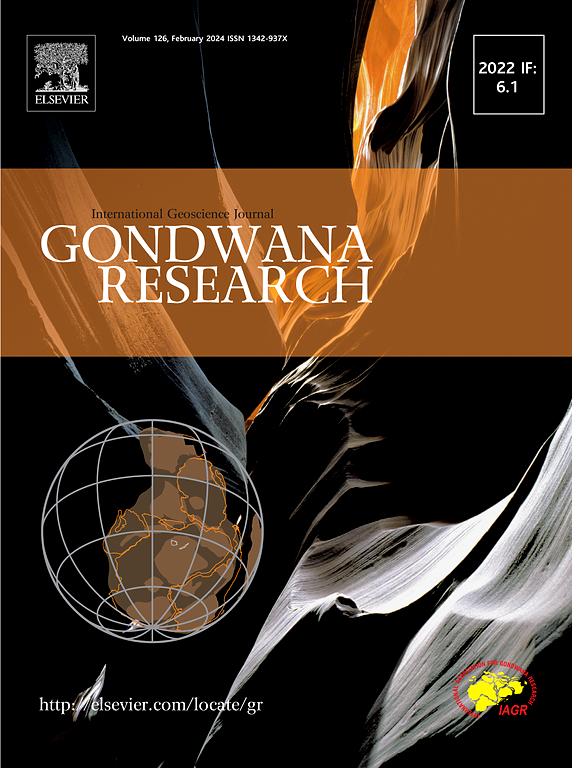A review of Mesozoic geodynamic evolution of the North Makran (SE Iran): A tale of a Neo-Tethyan ocean vanished due to two coexisting subduction zones
IF 7.2
1区 地球科学
Q1 GEOSCIENCES, MULTIDISCIPLINARY
引用次数: 0
Abstract
This paper presents a synthesis of the geological features of each tectonic unit of the North Makran (SE Iran), integrating results of multidisciplinary analyses, including structural and stratigraphic studies, petrographic and geochemical analyses, thermobarometric studies, as well as biostratigraphic and geochronological dating. This wealth of data forms the basis for a novel geodynamic model of the Jurassic − Eocene evolution of the Neo-Tethys realm, which evolved between the Arabian Plate and the Lut Block. The features of the North Makran tectonic units support the existence of a mid-ocean ridge setting during the Jurassic – Early Cretaceous. Contrary to previous interpretations, the data from these tectonic units suggests a single oceanic basin separating the Arabian and Lut continental margins, without the interposition of a microcontinental block. In the Early Cretaceous, subduction initiation is recorded by volcanic arc assemblages accommodating the convergence between the Arabian Plate and Lut Block. The nucleation of an intra-oceanic subduction marked the separation of the North Makran Ocean from the Neo-Tethys. The Late Cretaceous was characterized by plume-related magmatism and the onset of the convergence in the North Makran Ocean, inducing its subduction beneath the Lut Block. This subduction is recorded by volcanic arc assemblage and high pressure and low-temperature metamorphism within a subduction complex. Meanwhile, intra-oceanic subduction persisted within the Neo-Tethys, accompanied by a subduction complex and arc magmatism. The final closure of the North Makran Ocean occurred during the Late Cretaceous –Late Paleocene with the progressive amalgamation of the two subduction complexes and the deformation of the interposing oceanic lithosphere. This study suggests that the subduction of a seamount chain in the North Makran Ocean played a key role in the shortening and closure of this basin. This research emphasizes the importance of considering multiple factors in understanding the tectonic evolution of the Neo-Tethys realm.

北马克兰(伊朗东南部)中生代地球动力学演化述评:一个新特提斯海洋因两个俯冲带共存而消失的故事
本文综合了北马克兰(伊朗东南部)各构造单元的地质特征,综合了多学科分析的结果,包括构造和地层学研究、岩石学和地球化学分析、热气压研究以及生物地层学和地质年代学研究。这些丰富的数据构成了新特提斯领域侏罗纪-始新世演化的新地球动力学模型的基础,该领域在阿拉伯板块和卢特地块之间演化。北马克兰构造单元的特征支持侏罗纪-早白垩世洋中脊环境的存在。与之前的解释相反,来自这些构造单元的数据表明,一个单一的海洋盆地将阿拉伯大陆和卢特大陆边缘分开,没有微大陆块体的介入。早白垩世,适应阿拉伯板块与卢特地块交汇的火山弧组合记录了俯冲的起始。洋内俯冲的成核标志着北马克兰洋与新特提斯洋的分离。晚白垩世以羽状岩浆活动为特征,北马可兰洋开始辐合,导致其向卢特地块俯冲。这种俯冲是由俯冲杂岩内的火山弧组合和高压低温变质作用记录的。与此同时,新特提斯内部持续存在洋内俯冲,并伴有俯冲复合体和弧岩浆活动。晚白垩世-晚古新世,随着两个俯冲复合体的逐渐融合和穿插其间的海洋岩石圈的变形,北马可兰洋最终闭合。研究认为,北马可兰洋海山链的俯冲作用对该盆地的缩短和闭合起了关键作用。本研究强调了在理解新特提斯地区构造演化过程中考虑多种因素的重要性。
本文章由计算机程序翻译,如有差异,请以英文原文为准。
求助全文
约1分钟内获得全文
求助全文
来源期刊

Gondwana Research
地学-地球科学综合
CiteScore
12.90
自引率
6.60%
发文量
298
审稿时长
65 days
期刊介绍:
Gondwana Research (GR) is an International Journal aimed to promote high quality research publications on all topics related to solid Earth, particularly with reference to the origin and evolution of continents, continental assemblies and their resources. GR is an "all earth science" journal with no restrictions on geological time, terrane or theme and covers a wide spectrum of topics in geosciences such as geology, geomorphology, palaeontology, structure, petrology, geochemistry, stable isotopes, geochronology, economic geology, exploration geology, engineering geology, geophysics, and environmental geology among other themes, and provides an appropriate forum to integrate studies from different disciplines and different terrains. In addition to regular articles and thematic issues, the journal invites high profile state-of-the-art reviews on thrust area topics for its column, ''GR FOCUS''. Focus articles include short biographies and photographs of the authors. Short articles (within ten printed pages) for rapid publication reporting important discoveries or innovative models of global interest will be considered under the category ''GR LETTERS''.
 求助内容:
求助内容: 应助结果提醒方式:
应助结果提醒方式:


